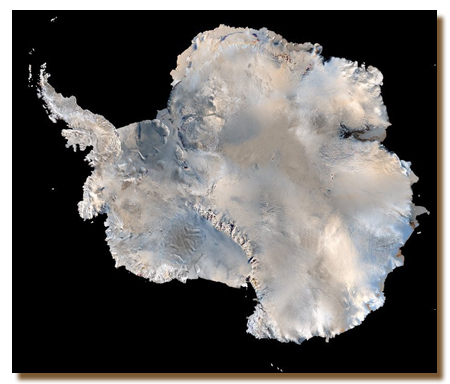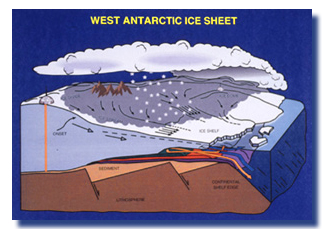Ice Sheets
The essence of Antarctica is glacial ice cover. The ice, which has accumulated over millions of years, is up to 3 miles deep and covers about 5.3 million square miles, or about 97.6 percent of the continent. This volume of ice amounts to about 6 million cubic miles if it were returned to the oceans, it would raise global sea level about 200 feet.

Antarctica is composed of two major, geologically distinct parts bridged by a vast ice sheet. East Antarctica, the larger of the two, is roughly the size of the United States and is composed of continental crust covered by an ice sheet that averages 1.6 miles in thickness. West Antarctica, the smaller portion is a mosaic of small blocks of continental crust covered by the West Antarctic Ice Sheet and an Andean-like mountain chain forming the Antarctic Peninsula. Most of the West Antarctic Ice Sheet is grounded below sea level, in places over 1.5 miles below sea level.
These two ice sheets cover all but 2.4 percent of Antarctica's 14 million square kilometers. At its thickest point the ice sheet is 4,776 meters deep. It averages 2,160 meters thick, making Antarctica the highest continent. This ice is 90 percent of all the world's ice and 70 percent of all the world's fresh water.
The West Antarctic Ice Sheet contains more than 3.2 million cubic kilometers of ice, is the last ice sheet on Earth resting in a deep marine basin and is the most likely player in any future, rapid sea level rise. Glacial geologic studies of land and marine-based deposits in the northern hemisphere, where most marine ice sheets once existed, have shown that this type of ice sheet is inherently unstable and vulnerable to rapid collapse. Nearly 90 percent of the ice flowing across West Antarctica converges into ice streams that are the most dynamic, and perhaps unstable, components of the ice sheet. Recent glaciological observations have yielded evidence that some of these ice streams may be responding to climatic and sea-level changes of the recent past—changes that could lead to more rapid retreat and global sea-level rise in the future. A few active volcanoes may also affect the ice sheet's behavior.



